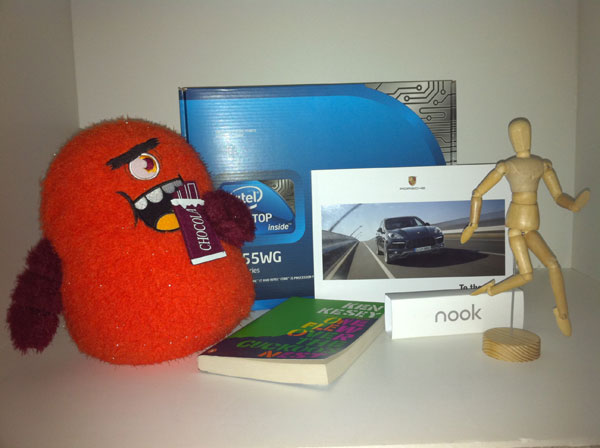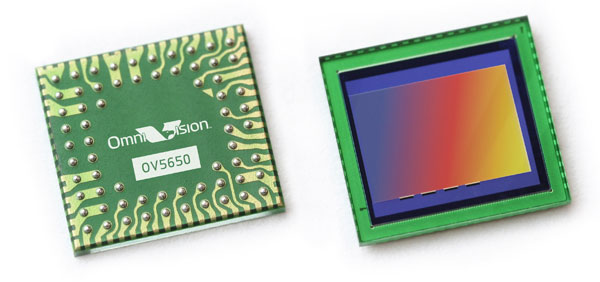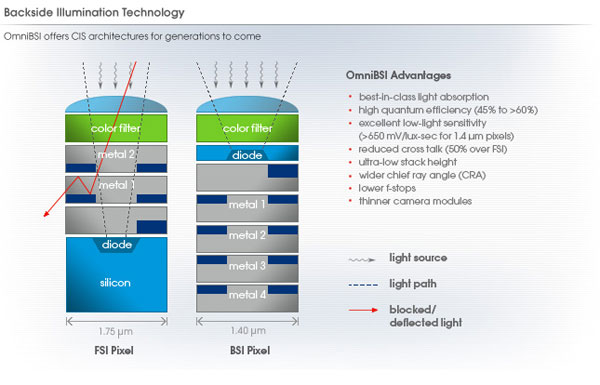Apple's iPhone 4: Thoroughly Reviewed
by Brian Klug & Anand Lal Shimpi on June 30, 2010 4:06 AM EST- Posted in
- Smartphones
- Apple
- iPhone 4
- Gadgets
- Mobile
Welcome to 2010, Apple Upgrades its Camera
The iPhone 4 is equipped with two cameras: a 5 megapixel camera with LED flash on the back of the phone and a VGA camera with no flash on the front. The LED flash works in both still and video modes. Like the EVO 4G, the iPhone 4‘s flash allows you to shoot in perfect darkness. If you’re filming a video in low light the LED will stay illuminated while you’re recording.

Taken with the iPhone 4 in total darkness
The same unfortunately can’t be said for the front facing camera on the 4. In anything but good lighting you’re going to get noise. It’s really only useful for FaceTime (or as an alternative to a mirror) and even then you need to be well lit for it to look decent.
Apple has opted for a 5 megapixel OmniVision sensor for the rear camera on the iPhone 4. What's interesting is that Apple has decided to bring backside illumination front and center with their marketing.
Backside illumination improves the sensitivity of CMOS and CCD detectors by reducing the amount of material in the path of incident light. In a frontside illuminated detector, a considerable amount of light is lost due to absorption that doesn't result in emission of an electron, in addition to reflection off pixel structures and electrical components near the frontside surface. Backside illumination greatly improves sensitivity by flipping the stack over. Instead of light having to pass through and possibly be reflected by metal structures, it is converted into electrons and read out by passing solely through silicon. Creating a backside illuminated part isn't as simple as flipping a sensor over, however, as manufacturers also generally thin the silicon light has to pass through before it can reach the photodiode. This further improves sensitivity and is generally accomplished through chemical etching in acid or by lapping (physically grinding) sensors at wafer scale.

OmniVision OV5650 - iPhone 4's rear camera SoC
Though backside illumination (BSI) improves quantum efficiency (how many photons are converted into electons), backside illumination is hugely important for another serious reason as well. Because the sensor is small at 4.6 mm by 3.4 mm, pixel size is also extremely small at just 1.75 microns square for the OV5650 in the iPhone 4 (state of the art sensors are 1.4 microns square, like those in the HTC Incredible's 8 MP sensor). Frontside illuminated parts generally have in the neighborhood of 10-15 microns of silicon before the active region of the photodiode where one wants photons to get converted to electrons. The result is that without backside illumination, pixels have a 10:1 ratio of height to length, you can visualize them as looking something like long square pillars. But that's a problem.
As photons are converted into electrons in that silicon, there's no guarantee that it will immediately travel down into the gate structure below to be read out by the camera. Electrons drift as they descend these columns, meaning that photons incident on one pixel don't necessarily map to the gate below. Because the smartphone camera sensors are so small, with a 10:1 ratio of height to size, the result is large amounts of so-called quantum blurring from electrons traveling into the gate structures of adjacent pixels. The result is a blurry image (and a decrease in MTF at the sensor level!), thus not representing the image that used to be incident on the sensor.
OmniVision and other smartphone CMOS sensor manufacturers thin that column down in an effort to come closer to having the pixel look more like a cube than a huge pillar. Ballpark numbers are between 3 and 6 microns, down from 10-15. The result is much more sensitive sensors that are higher resolution. While megapixels don't necessarily matter, neither does pixel size as much anymore; it's all about quantum efficiency, which is what engineers really care about.

OmniVision BSI - Courtesy OmniVision
The optical system of the iPhone 4 is difficult to characterize without disassembly, though the focal length is a bit shorter than previous iPhones. The result is that the photos are demonstrably wider angle. Backside illumination also allows for a bigger chief ray angle, higher numerical aperture (and thus lower f/#), but I won't bore you with the details.










270 Comments
View All Comments
scarnie - Thursday, July 1, 2010 - link
See my article here: http://bit.ly/5pxjgkBasically, the iPhone 4 is about 33% faster than the 3GS (600MHz) and 25% slower than iPad (1GHz) putting it squarely at 800MHz.
Cheers,
Stu
heri16 - Thursday, July 1, 2010 - link
Since it has been confirmed that Apple would not be able to beat physics, the best way for them is to issue a firmware update to hide the signal loss in terms of bars (GASP!) . Since after-all, calls won't be dropped at one bar, why make us all worry?From my tests, attenuation by water-containing bodies is always a problem to RF. My best way around has been using micro-strip circular polarized antennas to reduce the effect. I've been using such antennas to cut 2.4Ghz signals through dense trees, which have "waterly" leaves. It also works better in rainy conditions compared to linear antennas.
(My tests shows reduction in attenuation by 70% in dbm units for my modded 2.4Ghz enterprise router through those same trees.) This will work since our hands/bodies are "waterly" too.
My suggestion to Apple to is have both thin circular-polarized micro-strip antennas embedded in the back surface, and linear polarized antennas at the sides, and diversity-RF controllers to get improved best-case and worst-case performance.
I'm not sure whether an iphone accessory maker can create the same fix through a paper-thin antenna plugged in.
heri16 - Thursday, July 1, 2010 - link
Here are some links to help understand the iphone RF fix.http://en.wikipedia.org/wiki/Circular_polarization
http://en.wikipedia.org/wiki/Microstrip_antenna
NordicNINE - Thursday, July 1, 2010 - link
I finished up work & school for the day and just popped down to relax. Brought up my favorite tech news site and started the recorded DVR shows. I pulled up this article and then the recording of the new Futurama started up.Xeeros - Friday, July 2, 2010 - link
Not to nitpick but The Incredible has 8GB internal PLUS the microSD which Verizon gives you a 2GB stick so it would be 10GB stock as they now package the SD card in the phone. Had a Launch unit and the refresher that says Droid on the box versuses the HTC incredible box. ONly difference was my store gave me a card for the 2GB and now its pre-packaged. To be honest most review sites that have it listed in comparison have it labeled this way, so probably not your fault.sporadic - Friday, July 2, 2010 - link
A question though:When you ran your PDF download tests were you using any encryption or was this on an open network?
dhvanii - Friday, July 2, 2010 - link
This is a great article on i4 antenna and DL reception. I have a few questions.1. if you take 1.5 MHz channel bandwidth, then the lowest signal strength measurable should be around -112 dBm. But this WCDMA and so if it is 4.5 MHz the lowest RSSI should be -107 dBm. Add to that a 4-6 dB noise figure and the lowest RSSI should be around -100 dBm. How is the device reporting -113 dBm for 3G ? Is that only for GSM reception where it is 200 KHz channel bandwidth and so theoretical lowest is around -120 dBm ?
2. How about UL ? What is the Max Tx Power of this device ? 23 dBm ? How is that affected by this antenna glitch. Radio link protocols requiring UL acks for DL packets will definitely get affected by this poor antenna performance if UL is also affected.
Thanks again for your detailed analysis.
navderek - Friday, July 2, 2010 - link
Well I'm glad we agree...to be honest I did not read the entire article, but only the section about the antenna issues with the handset.I did not see you bring up the point of CQI, nor did I see you mention that RSSI is really not a good measure for network coverage / quality (when used alone). Perhaps you've mentioned it in other articles, and if so a link to those would have been warranted for charities sake.
Have you ever considered writing up an article about how the air interface works? I think everyone would be much further ahead if they had a good basic understanding of the air interface and how the handset communicates with the BTS...especially now with so many networks competing it would put a little more power into the consumers hands to judge the quality of the network rather than rely on their silly marketing adds and crappy signal strength bar displays.
Finally, you said that at -107dB the iPhone4 "deals just fine" with it. Do you have data to back that up? What kind of data rates were you getting? I'd be surprised if you could even hit 1MB/s.
Just so you know, I work for TELUS Mobility in Canada. We have the first TRUE "all IP" network running in North America. We launched back at the end of 2009 with a 3.5G network. In my area we use NSN equipment and in practical use you can easily get sustained data rates greater than 10MB/s (downlink, theoretical = 21MB/s). We are also talking latencies of less than 50ms and almost no jitter....how did we do this? Well we are the only company in North America to have built the network from the ground up using IP transport all the way to the radios. We have fiber going to every single tower which serves only this 1 network (we have 2 others to manage as well, PCS / iDEN). :-) I'm not trying to prop-up my company or anything, but just giving a hint as to why other carriers such as AT&T have so many problems with their "patchwork" network which still most likely uses legacy copper circuits multiplexed and converted into IP packets...this puts significant strain on the core to keep up with the demands.
If people understood the air interface protocols in a general and basic sense at least they could judge the quality of this part of the network and then focus on looking into the other parts...I just find it frustrating that most people who don't understand how it works tend to give the network a "basket" rating based on simple RSSI measurements which does not really give much insight except as to how much radiation your standing in.
zmslink - Friday, July 2, 2010 - link
So the net effect is that iPhone 4 drops fewer calls then the 3GS despite losing as much as 24dB when held "incorrectly," but does that signal loss affect battery life much?davidcjones - Friday, July 2, 2010 - link
It is amazing how someone can do such detailed research to get to the bottom of this!Thanks for your hard work. Of course, I am distressed that people are so inclined to run to the courts to file class action suits before they actually investigate the issue in detail...
David Jones
Jericho, VT